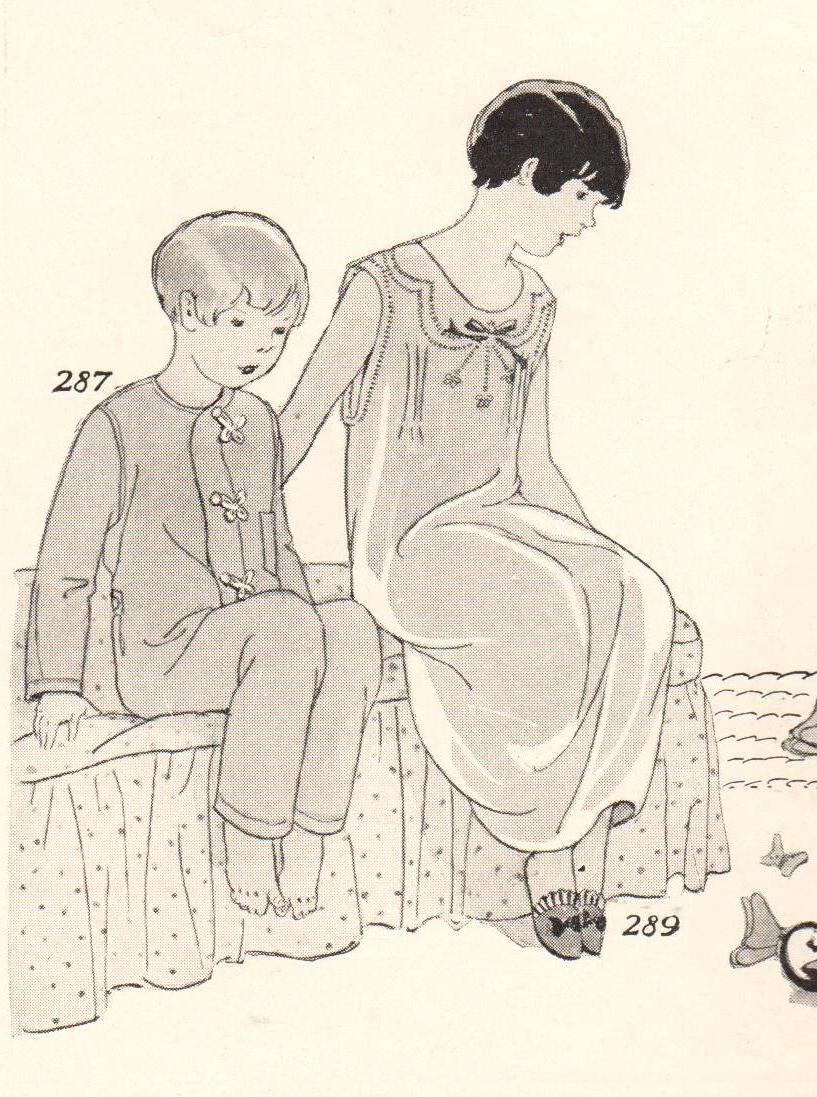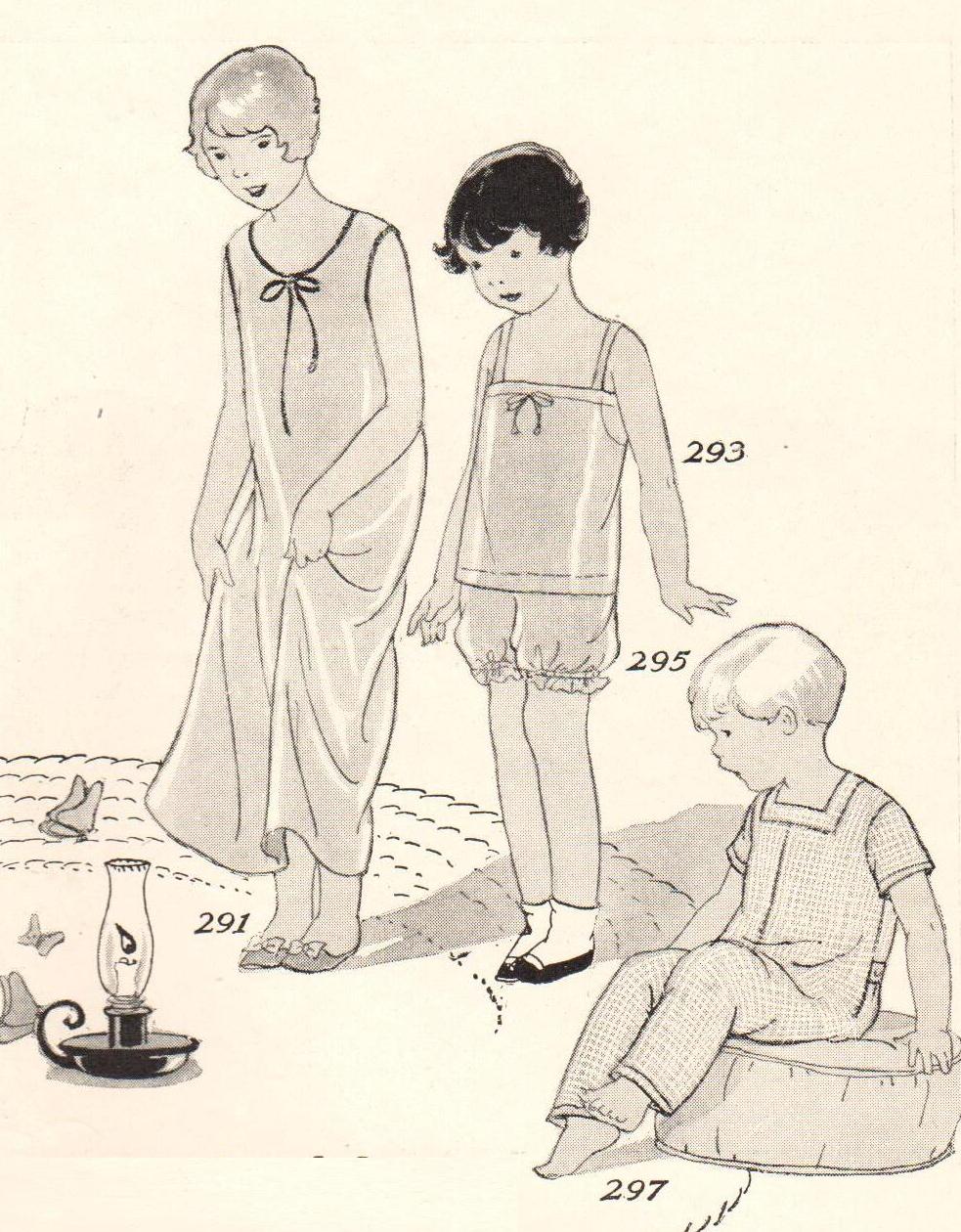
American Catalogs: Franklin and Simon Sleepwear (1927)

Figure 1.--The 1927 Franklin Simon catalog had a page on children's sleepwar and underwear. The title for the page us 'Underyhings both practical and smart for little girls and boys'. Sleepwear was seen as underwear. Here we see girls wearing both pajamaa and a nightshirt called a nightrobe. Pajamas first appeared in America (!880s), but at first were worn only by men. By the 1920s some girls were also wearing them as we see here. Notice the Chinese styling.
|
|
The top group of illustrations on this Franklin bd Simon catalog page offers mostly sleepwear. We see both pajamas and nightshirts (called night robes here). Sleepwear through the 19th century was mostly nightshirts for men, women, and children. Pajamas first appeared late in the century (1880s). And it was when who began wearing them first. It was a Briutish influence originating in India--pajamas a coruption of a Hindi word. Women at first resisted pajamas believing that it gave them a manish look--even identifying them with sufergettes. Gradually more and more men and boys began wearung them. Pajamas were widely worn by men and boys (1910s). Only elderly men contuinued wearing nightshirtd. We can see the impact here on children's sleepwear. The boy and one of the girls wear pajamas. Notice that they are one-piece pajamas with drop sears, still fairly common. The styling is also interesting. The girl's pajamas have Chinese styling. There was considerable interest in China at the time. Oriental art began to inflence Western art (1880s). An art historian writes, "Visual modernism in America is not a sudden, revolutionary rupture with the past, but a continuous evolution and a multifaceted synthesis, which included the artistic influence from East Asia." There was also an indluence with the fashion industry. One fashion historin writes, "1920s fashion wasnít just about flappers and fringed dresses. Traditional designs from China and Japan had a big influence on Twenties style with trends like kimino-style coats and robes and richly embroidered fabrics becoming popular." Another important influence was aathervdisparate group with a focus on the Chinese people--Christian Missionaries. Charlie Cgan was a popular figure in books and movues (beginning in 1926). Soon after Pearl Buck's Good Earth was a sensation (1931). This would be a factor in Americabn foreign policy eventually leading to Pearl Harbor and the Pacific War. The Chinese influence was strongest with girls. The boy's pajamas are styled like Koveralls--a boy's play garment. Nightshirts continued to be worn by girls. One girl looks to be wearing underwear. We are unsure if that meant that this underwear outfit was worn to bed. It may be that it was just a marketing desire to get more underwear into the page offerings.
Model 287: Pajamas
Here we see a girl's one-piece pajama outfut, Notice the dropseat. Boys appeared first as a man's garment, but by the 1920s, fashionavle women and girls were also wearing them. Nightshirts were probably more common for girls, but pajamas were an acceptable alternative. The 287 as copy read, "One-piece cotton pajamas in pink, blue or white , finished with silk frogs. Sizes 2 to 12 years $1.00." Silk frogs are fasteners that havenothing to do with frogs. They aee ornamental braiding, consisting of a button and a loop, for fastening the front of a garment. The purpose of frog fasteners is to provide a decorative closure for a garment; frog fasteners are usual to garments of Asian design, such as a shirt or coat with a mandarin collar, which may feature frog fasteners at the shoulder and down the front of the garment. In theWest they are perhaps best know for use in elaboate early-19th century military jackets. By the 1920s, modern color conventin had began to be established. The blue option here was probably not for a boy, but just because girls also liked blue.
Model 289: Nightrobe
Until the late-19h century, men, women, and childrn wore nightshirts to bed. It was the standing sleeping gaement. This one was skeeveles wih a low neckline nd embroidered decoration. . The model 289 ad copy read, "Hand embroidered silk crÍpe de Chine nightrobe in pink, tucked, with fine hemstiched design. Sign 4 to 12 years. $4.95." CrÍpe is usually a lightweight plain weave fabric with a crinkle, crimped or grained surface. Traditonally in was ome in silk or wool. crÍpe de Chine almost certainly means a silk fabric. This one is quite long down to her feet.
Model 291: Nightrobe
This is another very long nighthirt (figure 2). We are not sure if thee were shorter-length robes for younger girls, but as the oldest size was 12 years, even the younger sizes were probably long. There was a difference in price for the younger and older size so there could have been a fifference. The garment is called a nightrobe here. The modern term is nightgown. We believe that these nightshirts were most common sleepwear for girls, but as you can see, pajamas were also worn. This one was pink and a very plain sleeveless garment. Clearly by 1927, oink was a color striongly assiociated with girls. The only decoration is a small bow and what looks like decorative piping for the neck and arm openings. Apparently the piping and probably the ribbon was also done in blue. The model 291 ad copy reads , "Parfait glove silk nightrobe in pink, bound with blue. Sizes 4 ton 8 years. $2.95. Sizes 10 go 12 years. $3.95." This one was less expensive than model 289 because it does not have any elborate embroidery which can be expenive. We are not sure what parfait silk is.

Figure 2.--The illustration at the top of the 1927 Franklin Simon catalog a page on children's sleepwar and underwear had mostly sleepwear, pajamas and nightshirts. Here we see a girl wearing nd a nightshirt called a nightrobe and a boy wearing pajamas which are described as night drawers. They are tyled like Koveralls. For some reason they placed a girl wearing underwear in with the sleepwear illustrations.
|
|
Models 293 and 295: Vest and Bloomers
These garments are shown together at the top of the page with sleepwear, although we think they were more underwear than sleepwear (figure 2). We are not even sure that many girls wore these garments to bed. The model 293 or top/vest ad copy read, "Parfait glove silk vest in pink or white. Sizes 4 to 12 years. $1.35." Vest mean to or undershirt. We are not sure what parfait silk meant, but it was apparently a high-quality silk used to make gloves. Notice that pink and not blue was on offer. This suggests the mnodern color convenbtions were taking hold. The model 295 or bottom/bloomer ad copy read, "Parfait glove silk bloomers in pink, white, navy, blue, or tan. Sizes 4 to 12 years. $1.65." The range of color shows that the bottoms were not always bought to be worn with the top show on the page. The range of colors seem to match the colors of the skirts and hosiery worn by the girls. As the top never showed, there was no need to match. And the convention for underwear was normally white or other light color. The prices are also interesting. Prices like $1.35/1.65 may not sound like an expensive price, but in 1927 that was a price that most American parents could or would not pay for children's undewear. A further indication that Franklin Simon was an upscale store.
Model 297: Night Drawers
This pajama garment is shown being worn by a boy (figure 2). We don't think it would have been worn by a girl. Girls at the time did not wear pants. An exception sees to have been pajamas, at least to some extent. But notice the pajamas the girl is wearing have Chinese styling (model 287), a bit of a cultral out. The garment here is styled like Koveralls--a boy's garment. The model 297 ad copy read, "Night drawers of white cross-barred dimity. Sizes 2 to 6 years." $.75." Actual Loveralls were dine in a more sturdy fabric--denim. We do not know why this garment is not styled pajamas. It is one-piece sleepwear, jut lkike the girl's pajamas. Night drawers seems like rather an akward term for it, especually because it was not just drawers, but the top as well. It had a dropseat just like the girl's pajamas.
HBC

Navigate the Boys' Historical Clothing catalog/magazine pages:
Return to the Main Franklin and Simon 1927 children's pajamas and underwear page]
[Return to the Main American mail order 1927 page]
[Main photo/publishing page]
[Store catalogs]
[Fashion magazines]
Navigate the Boys' Historical Clothing Web Site:
[About Us]
[Introduction]
[Activities]
[Biographies]
[Chronology]
[Clothing styles]
[Countries]
[Girls]
[Theatricals]
[Topics]
[Bibliographies]
[Contributions]
[FAQs]
[Glossaries]
[Images]
[Links]
[Registration]
[Tools]
[Boys' Clothing Home]
Navigate the Boys' Historical Clothing Web Site:
[Sailor hats]
[Flat caps]
[Sailor suits]
[Buster Brown suits]
[Eton suits]
[Rompers]
[Knickers]
[Tunics]
[Smocks]
[Pinafores]
[Long stockings]
[Underwear]
[Sleepwear]
Created: 5:46 PM 1/18/2019
Last updated: 5:46 PM 1/18/2019




